Safety Of Feeding Crop Residues With Pesticides To Dairy Cattle In A Mixed Farming Irrigation Scheme In Central Kenya
Abstract
The feeding of agricultural products previously sprayed with pesticides to dairy animals is a common practice in most intensive farming systems. This is due to diversification of agricultural practices in an attempt to increase food production for the growing human population which leaves limited land for grazing animals. Such animals are therefore supplemented with crop remains after harvest. The current study was undertaken in order to find out if pesticides used to spray crops fed to animals are eventually passed in milk which could pose a danger to consumers.
A total of 68 milk samples were collected from animals in Kibirigwi irrigation scheme since farmers often feed french bean remains previously sprayed with dimethoate and cypermethrin to their dairy animals. In addition, 34 samples of french bean remains were collected. The milk and french bean samples were analyzed for the above pesticides by use of a gas liquid chromatography and found to be negative. Another batch of 68 blood samples were collected from dairy cows and assayed for cholinesterase activity, before and after feeding on sprayed french bean haulms. There was no significant difference in cholinesterase activity pre and post feeding since the 95% confidence interval of the test statistic of the difference in activity included zero (-0.938, 1.291).
A total of 34 milk samples collected from the animals were analyzed for organochlorine pesticide residues. The samples were positive for eight compounds but their levels were low. These were fi-BHC, lindane, heptachlor, aldrin, heptachlor epoxide, P,P’DDE, dieldrin and 0,P’DDD.
A small feeding experiment was conducted where twelve healthy animals were fed on french bean forage 1, 3 and 7 days after spraying with dimethoate. Milk from animals fed on foliage 1 and 3 days after spraying contained pesticide residues while that from animals fed on foliage 7 days after spraying did not. Blood samples were also withdrawn from the
xi
experimental animals and assayed for cholinesterase activity before and after feeding. The difference in activity was found to be statistically significant since the 95% confidence interval of the test statistic of the difference excluded zero (-2.4289, -1.2377).
This study indicate that the level of contamination of french bean foliage is low after seven days postspraying. This important foliage is therefore safe to be fed to animals if withheld for at least seven days. The study also revealed low levels of contamination of cows milk with organochlorine pesticides
Publisher
University of Nairobi

